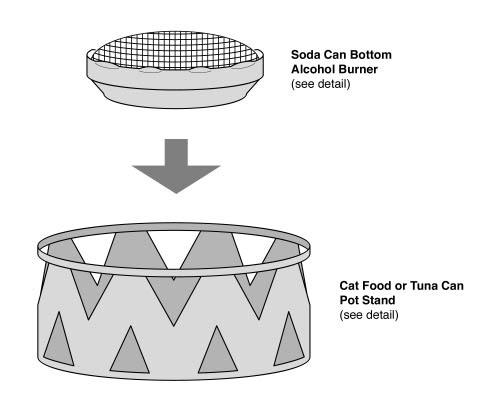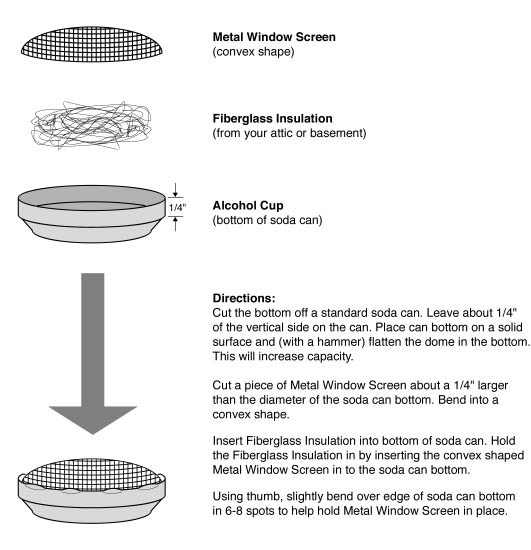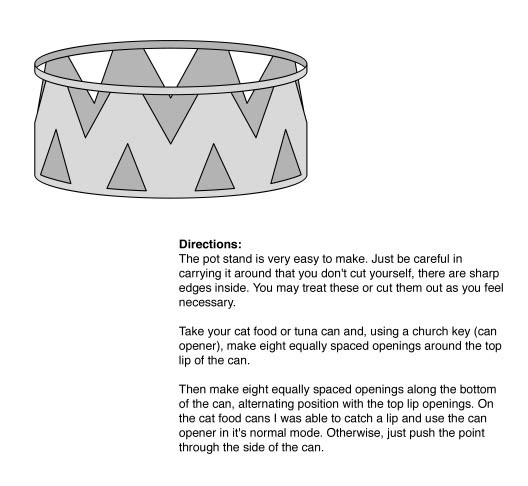
FIGURE 1 |

FIGURE 2 |

FIGURE 3 |

FIGURE 4 |

FIGURE 5 |

FIGURE 6 |
| My son "Ron" and I have been building homemade backpacking stoves for the last 8-9 months. We have built the "Photon", the "Cat", the John O.
Multi-fuel and others. We've tried alcohol, solid fuel (Esbit tabs) and
wood. It's been a great father/son experience. One of us would ask, "what
do you think about this?" and we'd go off to the garage and hack and bend
and fire it up.
Ron has requests from some his Patrol mates to either build them a stove or show them how (my preferred solution, but only under supervision of a leader or parent). I guess they are tired of lugging their gas & canister stoves around! Of all the other stoves we have tried, I find the Cat Food Can Stove easiest for younger people (my son) to use. Simply pour in the fuel and light. For myself, I'm torn between the efficiency of a Photon and simplicity of a solid fuel based design. Both have there drawbacks. The Photon, albeit more efficient, has more parts; the burner, pre-heat pan, plus a pot support and windscreen, thus more of a fiddle factor. The solid fuel system is far less complicated, but might require a second chunk of fuel to continue on to boil. What are we to do? What is the perfect stove for us? I don't think we'll ever answer these questions, but we're spending some fun (quality) time SAFELY experimenting to try to find the answers.
OUR STOVEThe stove we have made is still in the process of development and testing. It primarily burns alcohol but can also burn solid fuel. We have successfully boiled (to differing levels) several quarts of water on it without any adverse results to the stove. For our pots, we are using a Wal-Mart Grease Saver and a pot out of Mom's old Girl Scout mess kit. Our windscreens are made of roof flashing and oven liners. We carry white tipped matches (as our Troop has a rule about lighters) for ignition.It will boil 2 cups of cold tap water on 1/2 oz. of alcohol. No time is specified. When we go hiking together, be it with Scouts or not, we are spending good quality time together. Who cares if it takes 5 minutes or 8 minutes to boil the water? (rough timing puts it at about 6 minutes:))
STOVE ELEMENTSThe stove consists of two elements, the burner and the pot stand.The pot stand is made from a cat food or tuna can. All of these materials were found either in our recycling bin or around the house or workshop.Follow the directions in the illustrations.  BURNERThe burner is made from the bottom of a soda can, stuffed with fiberglass insulation and covered/held in place by a piece of metal window screen. See FIGURE 1. POT STANDThe Pot Stand is made from either a cat food or tuna can. See FIGURE 2. NOTESThe tabs created along the inner bottom of the can help to center the burner in the bottom of the can.FIGURE 3 - Shows the pot from Mom's Girl Scout Mess Kit on the pot stand. The bail has been removed and the brackets bent down to form hooks. Top is then kept secure with a hair tie attached to these hooks. See FIGURE 6. FIGURE 4 - The pot on the stove while burning. Without a windscreen, flames are slightly scattered. FIGURE 5 - Packing it up. The burner, pot stand and utensils are stored in the pot. A bandana is used to line the pot just to keep any nasty stuff from contaminating (another bandana is good to have around anyway!). FIGURE 6 - All set to go. Pot with contents and lid held on by hair ties. Nalgene fuel bottle with windscreen wrapped around it held on with elastic strap from old closed cell pad. Although on the heavy side, the Nalgene bottle is more of a "peace of mind" thing...I usually take it half full. With Scouts we need to demonstrate (and live by as leaders) proper storage of liquid fuels. For "non-Scout" hiking I have a nasal spray bottle that holds 3 oz. of fuel. Great for an overnighter. On weight...I put the stove, aluminum pot lifter, utensils, roof flashing windscreen and bandana in a Walmart Grease Saver pot and it weighed in at approximately 8.5 oz.. |
Donald Stier, 1/10/02
dstier@ga.prestige.net
Return to: [ Top of This Page ] [ Make Your Own Gear Page ]